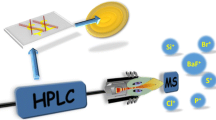Abstract
Mercury and arsenic are two elements of undoubted importance owing to their toxic character. Although speciation of these elements has been developed separately, in this work for the first time the speciation of As and Hg using two atomic fluorescence detectors in a sequential ensemble is presented. A coupling based on the combination of high-performance liquid chromatography (where mercury and arsenic species are separated) and two atomic fluorescence detectors in series, with several online treatments, including photooxidation (UV) and hydride generation, has allowed the determination of mercury and arsenic compounds simultaneously. The detection limits for this device were 16, 3, 17, 12 and 8 ng mL−1 for AsIII, monomethylarsinic acid, AsV, Hg2+ and methylmercury, respectively. This coupling was compared with an analogous one based on inductively coupled plasma–mass spectrometry (ICP-MS) detection, with detection limits of 0.7, 0.5, 0.8, 0.9 and 1.1 ng mL−1, respectively. Multispeciation based on ICP-MS exhibits better sensitivity than the coupling based on tandem atomic fluorescence, but this second device is a very robust system and exhibits obvious advantages related to the low cost of acquisition and maintenance, as well as easy handling, which makes it a suitable system for routine laboratories.



Similar content being viewed by others
References
Ebdon L, Pitts L, Cornelis R, Crews H, Donard OFX, Quevauviller P (eds) (2001) Trace element speciation for environment, food and health. The Royal Society of Chemistry, Cambridge
Gómez-Ariza JL, García-Barrera T, Lorenzo F, Bernal V, Villegas MJ, Oliveira V (2004) Anal Chim Acta (in press)
World Health Organization (1993) Guidelines for drinking-water quality, 2nd edn, vol 1. Recommendations. Geneva
C.E.E. Propuesta de Directiva del Consejo de la CEE 95/C131/03 DOCE 30/05/95
Burguera M, Burguera JL (1997) Talanta 44:1581–1604
Tsalev DL, Sperling M, Welz B (1998) Analyst 123:1703–1710
Boening DW (2000) Chemosphere 40:1335–1351
Le XC, Ma M (1997) J Chromatogr A 764:55–64
Ubillús F, Alegría A, Barberá R, Farré R, Lagarda MJ (2000) Food Chem 71:529–533
Gómez-Ariza JL, Sánchez-Rodas D, Giráldez I, Morales E (2000) Talanta 51:257–268
Ebdon L, Foulkes ME, Le Roux S, Muñoz-Olivas R (2002) Analyst 127:1108–1114
Armstrong HEL, Corns WT, Stockwell PB, O’Connor G, Ebdon L, Evans EH (1999) Anal Chim Acta 390:245–253
Gerbersmann C, Heisterkamp M, Adams FC, Broekaert JAC (1997) Anal Chim Acta 350:273–285
Ramalhosa E, Río Segade S, Pereira E, Vale C, Duarte A (2001) Anal Chim Acta 448:135–143
Liang LN, Jiang GB, Liu JF, Hu JT (2003) Anal Chim Acta 477:131–137
Casiot C, Alonso MCB, Boisson J, Donard OFX, Potin-Gautier M (1998) Analyst 123:2887–2893
Sun HW, Suo R, Lu YK (2003) Anal Sci 19:1045–1049
Sun HV, Qiao FX, Suo R, Li LX, Liang SX (2004) Anal Chim Acta 505:255–261
Gómez-Ariza JL, Lorenzo F, García-Barrera T (2004) J Chromatogr A (in press)
Chiou CS, Jiang SJ, Danadurai KSK (2001) Spectrochim Acta B 56:1133–1142
Acknowledgements
The authors acknowledge the Ministerio de Ciencia y Tecnología for financial support (project REN2002-04366-C02-02). F.L. and T.G.-B. are grateful to Junta de Andalucia and Universidad de Huelva, respectively, for their predoctoral grants.
Author information
Authors and Affiliations
Corresponding author
Rights and permissions
About this article
Cite this article
Gómez-Ariza, J.L., Lorenzo, F. & García-Barrera, T. Comparative study of atomic fluorescence spectroscopy and inductively coupled plasma mass spectrometry for mercury and arsenic multispeciation. Anal Bioanal Chem 382, 485–492 (2005). https://doi.org/10.1007/s00216-005-3094-7
Received:
Revised:
Accepted:
Published:
Issue Date:
DOI: https://doi.org/10.1007/s00216-005-3094-7



